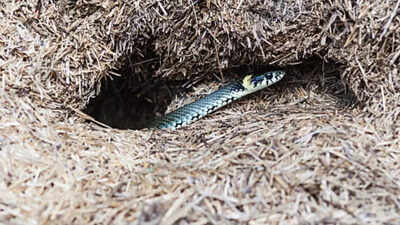ARTICLE AD BOX

When the sun lights up the sky and the summer season arrives in all its glory, the rattle of snakes is heard in the backyards around abodes. From March or April through October, snakes slither out from their period of dormancy not only in search of food but also partners.But how would you know if they make a house in your backyard? Look for these signs.
Size & shape

Image credits: iStock
A snake hole in your backyard will typically be about 1-3 inches wide, with round and smooth edges, since they slide in and out without disturbing the soil.
Signs of snake presence
To verify if the hole in your backyard belongs to snakes and not rodents, look out for shedded skins or even faint scale patterns in the nearby dirt.
Location

Image credits: iStock
Snakes are one of the smartest animals in the world.
Thus, their holes will not be in highly visible places but in sheltered locations that can provide them with consistent cover. They will be near home foundations, under decks, rock piles and next to sheds.
Environment
Snakes typically prefer damp environments near sources like ponds or drainage ditches so that they can use them for hunting and cooling off. Thus, check those areas more closely.
Dirt mounds

Image credits: iStock
Snake holes will never have dirt mounds around them.
However, when it comes to mole holes, rodent holes or chipmunk holes, they do have small dirt mounds nearby.
How to prevent snake holes in your backyard?
In order to prevent snake holes in your backyard, keep the lawn short and clean, seal any holes, eliminate any nearby water sources, use natural snake repellents such as clove oil, cinnamon oil or commercial repellents, install fencing, and most importantly, prevent rodent activity as it makes space for snakes. Disclaimer: The information provided in this article is for general awareness and educational purposes only. While the signs and prevention methods described may help in identifying or deterring snakes, they do not guarantee complete safety or elimination.



.png)
.png)
.png)
















 15 hours ago
4
15 hours ago
4








 English (US) ·
English (US) ·